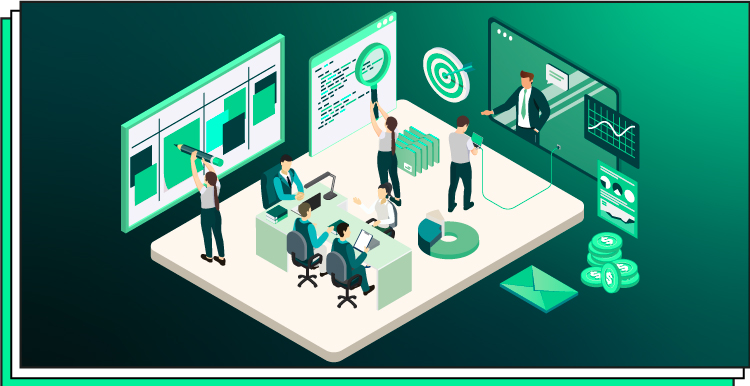Let’s be honest, too many IT startups are getting launched just because their owners decide they experienced some sort of mental breakthrough: an incredibly great product idea suddenly came to them! However, exclaiming “Eureka!” is not yet enough for a robust product base. Prior to starting a new project, you must execute decent market research and product validation. The price of ignoring these preparations is pretty painful: about 95% out of 30,000 new products started each year fail, according to Harvard Business School experts.
What is product validation? This is a method that mitigates the risks of failure and helps you ensure the lasting success of your IT products. This approach demands adopting a product validation plan to manage and maintain product-market fit. IT products that can undergo validation processes include mobile applications, websites, e-commerce projects, AR applications, professional software systems, game development, and much more.
In other words, product validation is a vital business process for IT and high-tech companies, which verifies whether or not a potential product is capable to address the needs and pain points of target customers. It is not a one-time action but a perpetual effort that accompanies the entire lifecycle of your IT product.
If a project manager fails to represent a product validation plan, the entire venture and all further investments are jeopardized as failure odds increase. At the same time, products that successfully comply with a validation procedure are most likely to sustain in the market. In this article, we’ll learn everything there is to know about the product validation process. If you require immediate help with IT product validation and discovery, contact our software system specialists for digital market consulting.
Step #1. Define Your Product: Product Validation Starting Point
Every product starts with a conception, which becomes subject to viability research and validation. This step includes the elaboration of your initial IT product idea, learning the market settings, and identification of your product’s main capabilities and killer features, a.k.a. unique selling points (USPs.)
Here is what you have to learn before proceeding to actual product validation activities:
- What market segments and groups do you want to approach with your potential IT product?
- Do you have a clear image of the pain points and demands specific to these market audiences?
- Do you have a vision of lifestyles and interests specific to your target audience?
- What technical resources and skills does your team possess?
- Can you change or enlarge your tech competencies, if required?
- Are you aware of the IT products currently available in this market segment?
- Will you be able to deliver a product resolving the pain points of your target group with the tech resources, skills, and capabilities available to you?
- Do you know how to fit your product into the interests and lifestyles of your target group?

If you gave comprehensive answers to these questions, you have sufficient information for making a draft of your product plan, including these components:
- An envisioned product scope, values, and advantages to be delivered to your customers in the context of healing their pain points and satisfying their needs.
- Product functionalities and capabilities that must be delivered in this regard.
- A market niche to be targeted and other marketing parameters of the offering.
- The target group of potential users (at least, preliminary customer personas.)
With the results of this minimum market validation research, you can go further to the phase of idea probation and original product validation. Following this algorithm can help you save plenty of resources: you’ll avoid starting a weak or poorly justified project before you invest in actual design, engineering, and development at the full scale.
Step #2. Conduct Market Research: Application of Product Validation Testing Methods to Your IT Product
Just as scientists test a hypothesis, project owners have to test their ideas and honestly decide if those ideas are worth being embodied in an IT product. There exist a number of efficient product validation testing and business intelligence methods. They can be used alone or in combinations. Let’s learn more about each of them:
Customer Interviews: Listen to Vox Populi
Conducting interviews with potential users of your IT product(s) can be one of the most effective ways to distinguish hypotheses from real needs and pain points. It’s important to let interviewees feel relaxed and offer a correct dialog scenario, like:
- Ask them if they use certain types of products and if they’re satisfied with them.
- Tell them about your product conceptions and ask for their opinions.
- Ask your interviewees to imagine themselves placed in certain situations and describe their reactions if they could solve them with your product.
- Ask them what’s lacking in the products they currently employ for the same purposes, if any…and so on.
Capturing customer feedback in regard to your ideas is not only crucial to confirm or debunk your product theories, but lets you get a better grasp of reality. This deductive approach will help you revise or enhance your hypotheses accordingly, without being guided away by your guesses.

You can resort to your current clients for interviews, invite people from the web, organize workshops at conferences, or consider other channels to draw the attention of your potential audiences to your future product.
The objectives of customer interviews in the process of product validation:
- Obtain first-hand experience with potential users
- Let customers freely express their thoughts and feelings
- Collect their feedback, arguments, and suggestions
- Align your IT product conception with those expectations.
Product Validation Surveys: Let Them Vote!
Offer your potential customers brief and comprehensive surveys. Before conducting a survey, concisely identify your goals and areas of interest to formulate simple yet meaningful questions. Use a reasonable mix of closed, rating scales, and open-ended questions. Avoid using technical jargon or complex language that could confuse respondents. Unlike interviews, surveys allow respondents to rate specific aspects according to a scale you offer: this lets you measure information about your customers’ preferences or pain points, and assess their potential readiness to pay for your product. The more potential clients undergo your surveys, the better vision of the market landscape you can develop.
The objectives of customer surveys in the process of product validation:
- Collect measurable and qualitative information from potential customers
- Rate their pain points, and compare your hypothesis against the reality
- Identify the most frequent and impactful user demands
- Highlight the potential feature gaps in your product plan.
Deep Testimonial-based Market Research: Mine the Web
What is a market validation study of user-generated content? This method is accessible to all digital marketers and doesn’t require direct contact with external respondents, so it’s one of the cheapest and fastest ways to validate your product. Sometimes, this approach can include certain AI-based technologies and custom ML solutions to automate and accelerate data-driven analysis and business intelligence.
This technique requires reading or scanning hundreds of testimonials or requests found on the web: forums, mobile app testimonials, social networks, and other sources. By analyzing user-generated comments, marketers develop a better understanding of customer problems and expectations. Once you review a considerable amount of testimonials, you can identify patterns of user pain points and correctly validate your product ideas against those findings.
The objectives of market testimonial research in the course of product validation:
- Obtain insights into the pain points of your potential customers via analysis of existent feedback on the Web
- Avoid doing live interviews and surveys with respondents, because they can take more resources and time
IT Product Prototyping: A Cheaper Alternative to MVP
Before involving a costly full-scale mobile app development team, it’s faster and more affordable to create a UI/UX mockup that represents an early graphical version of your software product (a.k.a. prototype). Creating prototypes can be an effective way to test your product and gather feedback from potential customers without any coding.
This doesn’t require IT engineering and programming efforts, however, skilled UI designers can create an interactive application or website mockup that can be introduced to a focus group of potential customers who can interact with this model and communicate their impressions and concerns about their preliminary product experience.
The objectives of IT prototyping in the course of product validation:
- Simulate user experience and test it with potential users without building actual product functionality but only an interactive mockup/prototype
- Create an engaging product preview version that lets you approach users and validate your ideas with a test group.
Focus Groups: Good Old Brainstorming
Gather a group of individuals to discuss your product conceptions and brainstorm additional ideas: this group can consist of our team members or invited experts and potential users. Each group type can have its own goals and benefits. Focus groups can help you gather qualitative feedback on your product. Also, in addition to product validation, these groups are efficient in generating ideas and identifying potential roadblocks or challenges in the process of further product development and marketing.
The objectives of focus groups in the course of product validation:
- Ensure that your product solves real problems in a group of qualified individuals
- Collect and discuss as many product aspects as possible
Step #3. Building a Minimum Viable Product (MVP)
The next step in the product validation process is building an MVP. Once you ensure that your product conception is sufficiently valid for the market, it’s safe to step up and invest in a minimum viable product. This type of product development allows you to lay the fundament of your product and approach the audience in the shortest possible time. With the help of MVP, you can finally approve that your product solves a real problem and meets a real need, before creating a full-fledged product. This project covers the following actions and tasks:
- Identify several core functions of your future IT product (so-called killer features.)
- Involve a software development team to define the scope of the project features.
- Identify the best technologies: platforms, development frameworks, languages, and third-party components to be integrated.
- Create simple user interfaces that provide access to the basic and most important features of your MVP.
- Use a small testing team to achieve sufficient levels of MVP usability.
- Identify marketing channels to involve limited audiences (early adopters) for further live testing and improvement iterations.
Once you create an MVP, make sure to apply the following product validation methods:
User Testing
Distribute your MVP to limited user groups to validate it. Observe how the early users behave with your MVP and find out if the potential customers face any difficulties while interacting with your product. This can help you to identify areas where your product is confusing or difficult to use and make necessary improvements to overcome bottlenecks and rectify the spotted issues. However, the key priority in user testing is to learn whether the core functionality of your IT product works well for the targeted market needs and covers the users’ pain points. MVP testing can take several iterations before you polish it and prepare for full-scale development and market introduction.
A/B Testing
A/B testing means experimenting with two different versions of a product or feature to see which one performs better. This approach can also be used to test different pricing strategies, marketing messages, and user interfaces. A/B testing can be used as an integral component of MVP-based user testing, supported by focus groups and other product validation methods. You can use A/B testing iterations as many times as you find useful for refining the end result.
Step #4. Customer Feedback and Validation: The Only Way to Align Your Product with Reality
Every piece of customer feedback is highly precious. Regardless of the product validation methods you choose, it’s necessary to keep a detailed track of how the process goes and collect every piece of experience. Remember that customer feedback is the only way to make data-backed decisions and keep your product ideas aligned with reality and avoid wrong guesses. It’s important to keep a rigorous record of product validation efforts:
- Make a complete note of all observations, and obstacles you faced and resolved on each product validation step.
- Organize all information obtained through surveys, interviews, and testing procedures in Google documents or specific systems, like PIM systems.
- Make a sufficient analysis and store all conclusions and takeaways from everything done at each step of product validation.
- Once any valuable insights are acquired, make sure to transform them into actual suggestions and implement changes in your product development plans.
- All these activities require skilled product management efforts.
- TEST and ITERATE during the whole product life-cycle.
Best Practices in a Product Validation Plan
There exist several best practices that guarantee the soundest effect in the process of product validation. Let’s check them:
- Create a product validation plan: Develop a detailed plan for validating the product with timelines, milestones, and specific activities to be completed. This plan should be updated regularly as the product validation process progresses.
- Make sure the process of product validation involves all necessary specialists and experts that can contribute their knowledge and skills: Product managers, software engineers, usability specialists, customer service specialists, marketers, and developers.
- Maintain transparency and keep all team members updated: Use a system that all authorized stakeholders have access to and keep ticket-based management of meetings, operations, and improvements related to product validation and market preparations.
- Communicate: Maintain regular meetings to share progress and ideas on product validation with the stakeholders.
- Establish clear criteria and metrics that describe whether your product is validated, and ready for MVP or full-scale market introduction.
Conclusion
The product validation approach is a universal method that works for all IT products in any industry, including custom real estate applications, financial or banking software development, and transportation management systems. At Forbytes, we perfectly know how to organize and manage the product validation process throughout all phases and steps, including product idea discovery, market fit validation, identification of the key features, building an MVP, testing it out, and implementation of customer feedback. Contact us today for IT consulting and hiring a dedicated team for your project.

Our Engineers
Can Help
Are you ready to discover all benefits of running a business in the digital era?

Our Engineers
Can Help
Are you ready to discover all benefits of running a business in the digital era?







